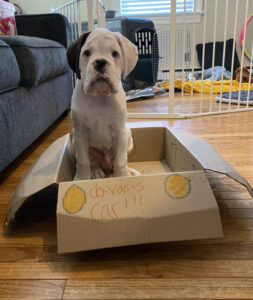It’s been weeks, maybe months of anticipation…The excitement of welcoming a new family member is overflowing. The thoughts of your new dog and how perfect they will be is thrilling! He should walk well on leash, not pull! Not steal things in the house, Leave-It! He should come back to me when I call him, why doesn’t he respond? He should greet people nicely, don’t jump in excitement or bark out of fear! He should tell me when he needs to go potty, but don’t scratch up the door or bark incessantly to go out.
We, our society, has somehow developed this preconceived notion that dogs are supposed to just fit into our culture and any situation we throw at them. That they will come into our home and know that we love and care for them and they should be grateful, RIGHT? That they should be able to communicate with us, but in a way that we understand! The expectations that many of us place on our dogs, especially new dogs added to the family, is just not fair or reasonable. In an effort to help our new family member blend well with our already established home, I have provided some tips below.
Tips for bringing your new dog (breeder or rescue) home:
*Don’t pick a dog on a whim! Do your research prior to bringing your new dog home. Know and understand the dog breed tendencies. If you can’t fulfill the needs of your dog’s breed, you are setting your dog and yourself up for failure.
*Keep your home quiet – no visitors for the first couple weeks.
*Keep your dog’s space small via management as they get familiar with you and their new environment (expand slowly)
*Provide comfortable quiet spaces (crate/dog bed)
*Don’t ask for too much too soon (Allow your dog weeks/months to just get to know you, their new home and navigate their routine)
*Should your home be a multi-dog home, provide SLOW introductions. This involves strong management via gates and crates and interactions in a controlled environment with parallel walks and active supervision.
*Allow your new friend to eat in peace (do not stick your hands in their food bowl or take it away from them)
*Keep them quiet during their adjustment period – No dog parks, No friends’ houses, No play dates.
*Get to know who your dog is and what THEY like – This will provide you with information on how to proceed with fulfilling your dog’s needs.
*Play games to build your bond and relationship – Easy Pattern Games (by Leslie McDevitt) is a great starting point.
*Love your dog for who they are, Not who you want them to be.
*Be proactive, NOT reactive, and get support from an ethical trainer to set a plan for your new family member in an effort to set everyone up for success and a happy life together!

-Christy Grossman, IAABC-ADT
Fear Free Certified Professional
Dog Bite Prevention Educator (Doggone Safe)

